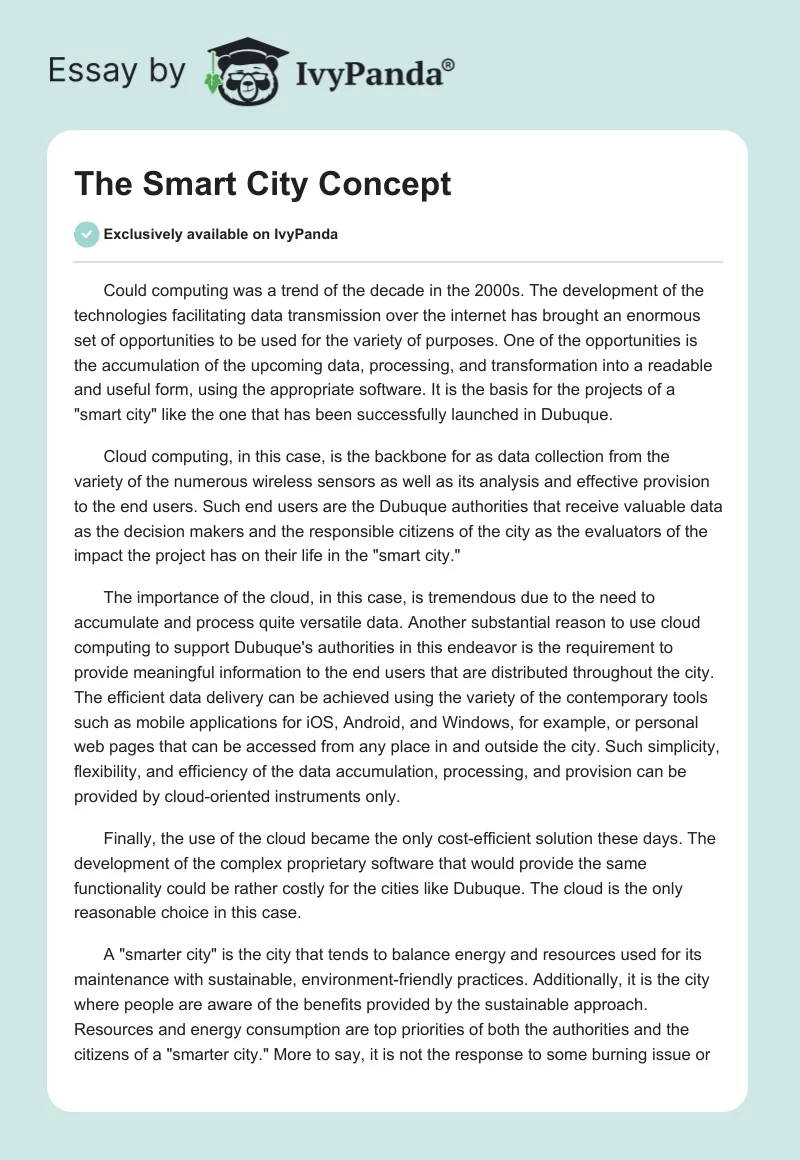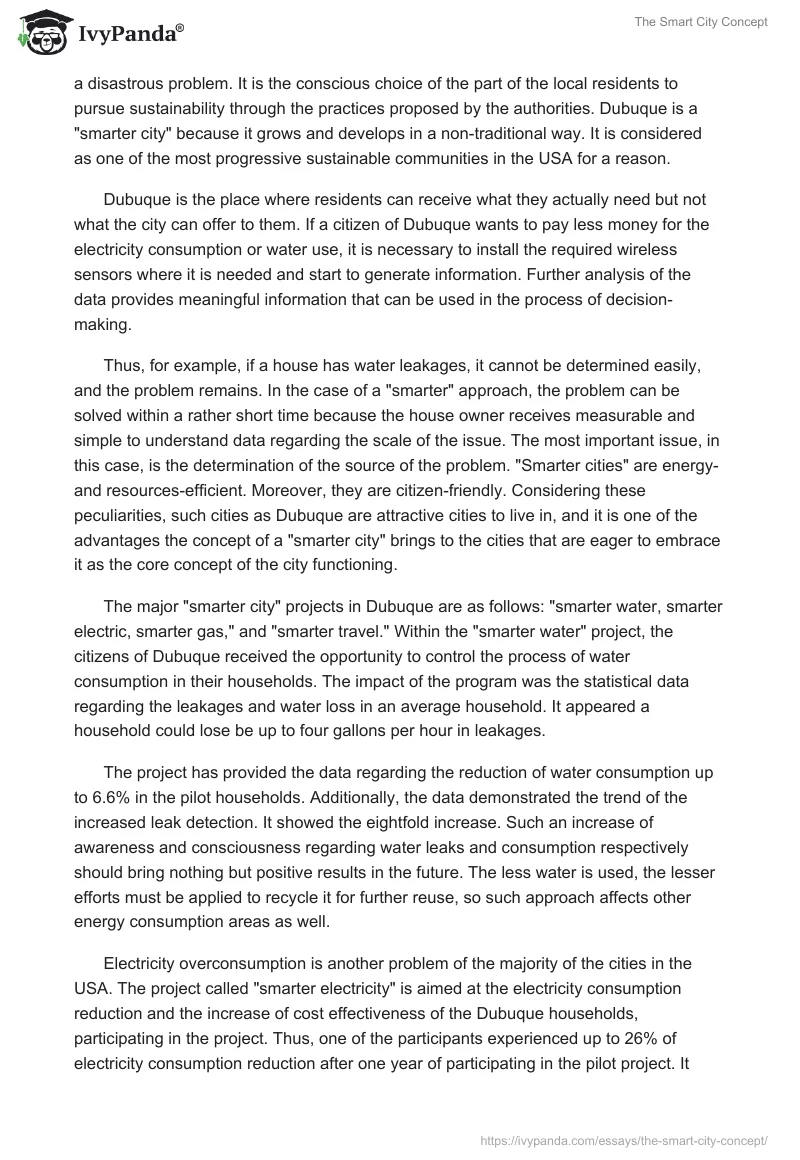Could computing was a trend of the decade in the 2000s. The development of the technologies facilitating data transmission over the internet has brought an enormous set of opportunities to be used for the variety of purposes. One of the opportunities is the accumulation of the upcoming data, processing, and transformation into a readable and useful form, using the appropriate software. It is the basis for the projects of a “smart city” like the one that has been successfully launched in Dubuque.
Cloud computing, in this case, is the backbone for as data collection from the variety of the numerous wireless sensors as well as its analysis and effective provision to the end users. Such end users are the Dubuque authorities that receive valuable data as the decision makers and the responsible citizens of the city as the evaluators of the impact the project has on their life in the “smart city.”
The importance of the cloud, in this case, is tremendous due to the need to accumulate and process quite versatile data. Another substantial reason to use cloud computing to support Dubuque’s authorities in this endeavor is the requirement to provide meaningful information to the end users that are distributed throughout the city. The efficient data delivery can be achieved using the variety of the contemporary tools such as mobile applications for iOS, Android, and Windows, for example, or personal web pages that can be accessed from any place in and outside the city. Such simplicity, flexibility, and efficiency of the data accumulation, processing, and provision can be provided by cloud-oriented instruments only.
Finally, the use of the cloud became the only cost-efficient solution these days. The development of the complex proprietary software that would provide the same functionality could be rather costly for the cities like Dubuque. The cloud is the only reasonable choice in this case.
A “smarter city” is the city that tends to balance energy and resources used for its maintenance with sustainable, environment-friendly practices. Additionally, it is the city where people are aware of the benefits provided by the sustainable approach. Resources and energy consumption are top priorities of both the authorities and the citizens of a “smarter city.” More to say, it is not the response to some burning issue or a disastrous problem. It is the conscious choice of the part of the local residents to pursue sustainability through the practices proposed by the authorities. Dubuque is a “smarter city” because it grows and develops in a non-traditional way. It is considered as one of the most progressive sustainable communities in the USA for a reason.
Dubuque is the place where residents can receive what they actually need but not what the city can offer to them. If a citizen of Dubuque wants to pay less money for the electricity consumption or water use, it is necessary to install the required wireless sensors where it is needed and start to generate information. Further analysis of the data provides meaningful information that can be used in the process of decision-making.
Thus, for example, if a house has water leakages, it cannot be determined easily, and the problem remains. In the case of a “smarter” approach, the problem can be solved within a rather short time because the house owner receives measurable and simple to understand data regarding the scale of the issue. The most important issue, in this case, is the determination of the source of the problem. “Smarter cities” are energy- and resources-efficient. Moreover, they are citizen-friendly. Considering these peculiarities, such cities as Dubuque are attractive cities to live in, and it is one of the advantages the concept of a “smarter city” brings to the cities that are eager to embrace it as the core concept of the city functioning.
The major “smarter city” projects in Dubuque are as follows: “smarter water, smarter electric, smarter gas,” and “smarter travel.” Within the “smarter water” project, the citizens of Dubuque received the opportunity to control the process of water consumption in their households. The impact of the program was the statistical data regarding the leakages and water loss in an average household. It appeared a household could lose be up to four gallons per hour in leakages.
The project has provided the data regarding the reduction of water consumption up to 6.6% in the pilot households. Additionally, the data demonstrated the trend of the increased leak detection. It showed the eightfold increase. Such an increase of awareness and consciousness regarding water leaks and consumption respectively should bring nothing but positive results in the future. The less water is used, the lesser efforts must be applied to recycle it for further reuse, so such approach affects other energy consumption areas as well.
Electricity overconsumption is another problem of the majority of the cities in the USA. The project called “smarter electricity” is aimed at the electricity consumption reduction and the increase of cost effectiveness of the Dubuque households, participating in the project. Thus, one of the participants experienced up to 26% of electricity consumption reduction after one year of participating in the pilot project. It meant for this household not only the reduction of electricity consumption but also the cut of the relevant expenditures as well. Therefore, “smarter electricity” is the part of the larger plan of resources consumption reduction in Dubuque. All projects launched in the city at the moment are the parts of the larger project aimed at the improvement and optimization of the resources’ usage.
The next move of Dubuque’s authorities after the successful development and implementation of such projects as “smarter water” and “smarter electricity” is the effort to combine all available information into one set of data to determine the interconnections between the different silos of data. These interconnections can provide the researchers with information regarding the factors that influence the development of the city in the positive and negative ways.
Such a merge of data is necessary to see the bigger picture of the situation in Dubuque and the ways of its improvement. The goal is to create such an information system that would track the current situation, determine the present and upcoming issues, and propose effective steps aimed at its improvement. Currently, these standalone projects provide only the minimal effect as they are aimed at particular areas that can be improved. The analysis of big data will provide Dubuque’s officials with information regarding the areas where improvements are needed first.
Prioritization is another benefit of such a system, so it is important for Dubuque to prioritize steps of the city’s improvement. Joint silos of information will play the most important role in the process of prioritizing the next steps because such a form of data organization will facilitate the analysis of the most comprehensive and full sets of information regarding the costs, expenditures, and issues essential for each strategic area of the Dubuque city’s household. It should be noted that this move would not require additional resources or efforts as data from the currently running projects would be combined and used. It means that such a merger of the projects’ databases should not stop any of the currently running projects.
Dubuque is not the only city in the USA that practices the “smart city” concept. Portland, Oregon, is another American city that extensively uses the tools that information technologies can provide. Microsoft, Forio, and Portland administration managed to obtain information from the variety of government agencies regarding the state of things for the past ten years in more than seventy-five city areas.
The effort resulted in the system that could be used for the variety of purposes and access online. There are several similarities as well as differences in the approaches of the authorities in these two cities. The following similarities can be outlined. The first one is the use of information technologies to collect and process the data about the vital systems of the city. A computerized approach to the data analysis is the most efficient one as of today, so it is used extensively everywhere.
The second similarity is the extent, to which the systems in Portland as well as in Dubuque are used. In both cities, nearly every critical system is explored, evaluated, and controlled using the computerized methods. It helps to respond to the upcoming issues much quicker and thus, provide more efficient and timely solutions in each given situation.
However, there is a drastic difference between the two systems used in these cities. The difference is in the system itself. While Dubuque uses the cloud to read and process the data from the numerous wireless sensors throughout the city, Portland’s authorities decided to go far and ordered the development of the modelling system that could predict and model the events that did not even happen yet. In other words, the system used in Portland is far more advanced than Dubuque’s one in terms of the modeling capabilities, which makes it so advantageous for the city management. The disadvantage is the lack of access to the real-world and up-to-date information as it can be done in Dubuque.
Comments
The system in Dubuque is the great achievement of the local authorities. It is the giant step towards the creation of the cost-effective, sustainable, and the environment-friendly community. The use of the cloud technologies and wireless sensors provides numerous opportunities for the further development of the system in the future. Wireless sensors can be installed literally anywhere, so such “smarter” projects can be developed for any critical as well as a non-critical system of Dubuque.
The simplicity of the system’s use is another outstanding achievement of Dubuque’s authorities. It does not require to be technically educated or to have some excessive knowledge in networking technologies to become the participant of the “smarter” projects in the city. It is an excellent idea in terms of involving new participants and obtaining more comprehensive volumes of the data.
Recommendations
The first recommendation is to extend the network of the wireless sensors and include other critical systems to the process of data generation. It should provide Dubuque’s authorities with a better understanding of the current state of things in the city. The next step of the officials should be the effort to create the system that would provide midterm and long-term plans of Dubuque’s development.
The current system provides up to date information only, tracking the changes in consumption rates. It would be wise to develop the system similar to the Portland’s system. Then, the wireless sensor network with its capability of generating real-time data should be integrated into the new planning system. It would add value to the both systems, creating very powerful and useful tool for the control, planning, and decision-making processes.
Conclusion
Summing, the paper explored the project in Dubuque aimed at the development of a “smarter city.” The most important issues were evaluated to provide the in-depth analysis of the current steps of the “smarter” concepts’ implementation. Current projects in Dubuque are very promising, and they appear to be the significant contributors to the process of making the city’s community cost-effective, sustainable, and environment-friendly.
Additionally, the paper explored the experience of the Portland’s authorities in creating and maintaining planning system that is supposed to provide them with information, critical for the decision-making process. The system in Portland appeared to be different but worthy of attention. The appropriate comments were provided to reflect upon the system in Dubuque and its potential. Finally, the relevant and useful recommendations were presented to demonstrate how the system in Dubuque could be improved. The current system required further improvement and development; therefore, the recommendations could be used as the guide.


